January 31, 2022
Getting a hotel room last night, even for five hours of sleep, had been a really good idea. When we walked back to the airport around 4:00 am, we saw people trying to sleep like they do in any airport, but they had installed tall transparent Covid partitions between every seat, making it impossible to stretch out. The boarding process went off without a hitch and we took off to Iquitos, Peru, a place we’d started to think we might never get to, for the most exotic part of the trip—an Amazon River adventure.
After our early morning flight to Iquitos, we were met at the airport by Jón from the Otorango Amazon River Lodge. Jón was 27, friendly, and barely five foot four inches tall. He would be our personal guide for the next five days.
Most of the vehicles at the airport pickup area were moto-tuk-tuks, but Jon led us to a waiting beat-up car taxi. The taxi took us on a wild ride into the busy town of Iquitos, which felt like Leticia on steroids.
The taxi made its way through noisy, uncontrolled traffic consisting of thousands of moto-tuk-tuks (and getting sideswiped by one, hence the beat-up car) and motorcycles, along with a handful of cars and small buses and no rules of the road. There were no lines painted on the roads for lane control, and traffic signs and stoplights were hardly even suggestions.
Eventually, we came to where the road narrowed too much for a car so we got out with our luggage and Jón flagged down a moto-tuk-tuk, which took us another mile or so on paved and then sandy roads until we got to a dock. Once there, we climbed into a beat-up 20-foot boat with an ancient (and legendary) Yamaha Enduro outboard. Jón introduced us to our captain, Manuel, who spoke no English.
It had taken perseverance, pivoting, and pricey extra flights, but within a minute of getting underway, we were suddenly on the Amazon River. Nearly two miles wide, it was half coffee, half milk with a slight avocado tinge color and flowing swiftly downstream to the east toward Brazil.
For years I’ve been a boating safety expert and accident investigator and written hundreds of articles on the topic. As I scanned the boat, I noticed the safety equipment consisted of and was limited to a single broken oar. There was no chart-plotter, no GPS, no horn, no flares, not even a VHF radio. Manuel expertly avoided the worst of the Amazon’s debris, stopping a couple of times in the murky water to clear the prop. Halfway to the lodge, the boat stopped mid-river and Manuel made his way to the back, pulled the engine’s fuel pickup from an open widemouthed jug and shoved it into another one, full of gas. I tried not to look.
Two bouncy, noisy hours later, the boat pulled into a tiny tributary and we glided to an old wooden dock. We were finally here. For most of the trip we weren’t sure what to expect here and for the last couple of days we didn’t know if we’d ever make it.
The lodge had a number of separate cabins with space enough for up to 20 people, but tourism had not yet returned to the Amazon rainforest and we were the only guests. Jón was all ours for as long as we were here. Jón spoke reasonably good English, had been trained for three years at a local tour guide school, had grown up the nearby village of Oran, and knew all about the natural surroundings—a perfect guide.
As we headed to our cabin, two huge and outrageously colorful scarlet macaws flew in front of us screeching like dinosaurs then resting on a branch outside the front window of our cabin. We were definitely not in Kansas anymore.
Our stay in the Amazon jungle would be a time to completely unplug. There was no internet, phone or text services for us, though there were some very basic phone services for the village that our phones couldn’t connect to. The lodge’s simple electricity needs (lights) were powered by solar and a small battery. There were no fans, which we would soon lament. There was a single electrical outlet in our cabin we could use to charge our phones—here, they would just function as cameras.
The meal schedule followed by the lodge was breakfast at 7 am, a large siesta lunch at 1 pm, and small dinner at 7 pm. We’d arrived around lunchtime and it was big. After lunch, we returned to our cabin to rest. Because we’d only slept less than five hours the night before and it was hot in our cabin, we both fell fast asleep after setting alarm for 3:30 pm when we were to meet up with Jón for a jungle hike.
We both woke up in a fog; neither of us are good nappers. But, in the heat, we donned our long pants and long-sleeved shirts that we’d treated with permethrin (a human-safe insecticide) before we’d left home, and put on tall rubber boots the lodge had provided. Then we both used some 100% DEET on any exposed skin. Jón told us that he still got bit by mosquitoes but suffered no welts or itching. He explained that the locals develop immunity to mosquito bite discomfort. Susan, on the other hand, is a mosquito magnet with no such tolerance and was prepared.
DEETed up, we headed out on our guided trek into the jungle near the lodge. Jón brought along Saul to help machete our way through the jungle, stopping every now and then to show us a plant or insect of interest. Saul was in his 40’s and a good four inches shorter than Jón, stocky with wide shoulders, an easy gait and a wide metal-filled smile. His manner was like an old west cowboy – silent and capable – and he spoke no English. We both liked him instantly. He lived in the nearby village and would be Jón’s helper throughout our stay, hacking through the jungle with his expertly-used razor-sharp machete and driving a small boat for our river explorations.
As we walked, Jón pointed out various birds, insects, animals and plants. The trees were alive with bird life, most of them making sounds we’d never heard before.
Bullet ants are the world’s most painful stinging insect and some say its sting is the worst pain imaginable for humans. Their sting leaves a person in absolute agony for as much as 24 hours.
We climbed up and down jungle gullies and dodged spiky things. An ant painfully bit me through my pants but since I wasn’t screaming in pain, Jón said it was probably just a black fire ant.
The tiny bright red poisonous dart frogs are among the most poisonous animals in the world for their size (which is about as big as your smallest fingernail). Saul found one hopping on a leaf and then Jón excitedly pointed out another that was carrying a couple of tiny tadpoles on its back, a rare find. The frog would carry the tadpoles up into a bromeliad high in a tree where the tadpoles could grow into frogs whose skin secretions are so toxic that simply rubbing the tip of a dart on the frog’s back could make the dart poisonous enough to kill a small person.
Within our first hour hiking we’d already seen the world’s most painful stinging insect and one of the world’s most toxic species. So far, the animals of the Amazon rainforest were not exactly cuddly.
Jón also pointed out trees in the jungle that would not be ones for tree huggers. Some of the trees, like walking palms had sharp spikes on their long “legs” to keep critters from climbing them. Jon showed us another plant, the annatto, that had a seed that indigenous people used to make a bright red paint for decorating faces. Touching an annatto’s seeds isn’t painful but, as Susan discovered after she touched the red seeds, the dye doesn’t easily wash off. As we hiked, we had to duck a few times to avoid getting tangled up in hanging vines, including bright pink dangling heliconia plants swinging from some of the trees.
Saul hacked our way through a hilly and muddy section of the jungle for a couple of sweat-drenched hours until our hike looped back to the mighty Amazon River where we saw several kinds of exotic birds, including the oropendola that builds strong nests that dangle a few feet down from high branches, protecting them from predators. Jón told us that another bird that builds similar nests is called a cacique, meaning boss, because the male “bosses” are polygamous and do nothing more than mate; females build the nests and raise young. Village leaders, Jón said, are also called caciques because they also do no work and are supported by the people.
The sun began setting as we walked along a path from the river back to the lodge. The path, we learned, also led to the village of Oran, less than a mile away, where we’d visit another day.
Back at the cabin, we enjoyed cool showers (cool being the only option and our preference in the intense heat and humidity) before heading to the main lodge for dinner. En route, the two huge scarlet macaws flew in front of us again, still screeching like dinosaurs.
After a well-prepared meal of fresh fish, rice, vegetables and local fruit juices, we turned in for the night. There was no moonlight and the cabin was pitch black when darkness fell. We laid in bed listening to the jungle noise. In the background was a constant pulsing sound similar to what you hear when your heartbeat is pounding. Layered on that were millions of crickets and small insects. An occasional chirping bird added to the sounds and some distant odd moaning coupled with another nearby sound like Kermit the frog mumbling competed with large leaves and twigs falling on the metal roof. It lasted all night; the jungle is never quiet.

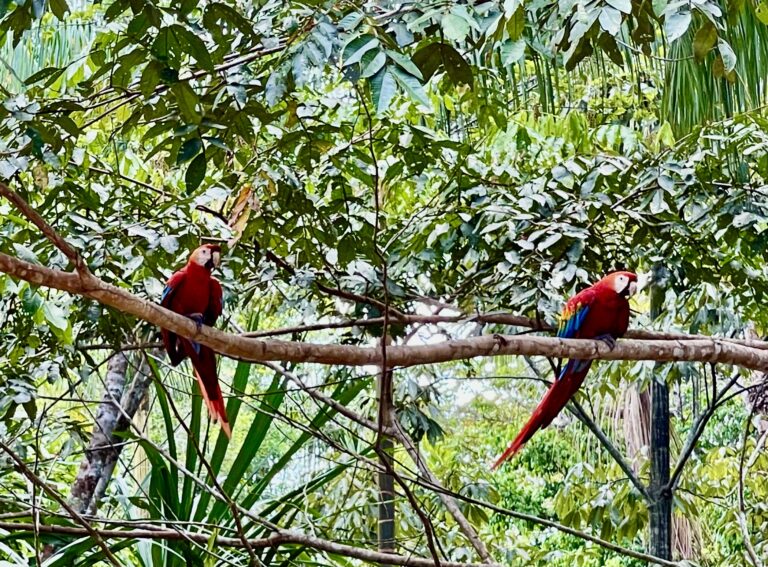
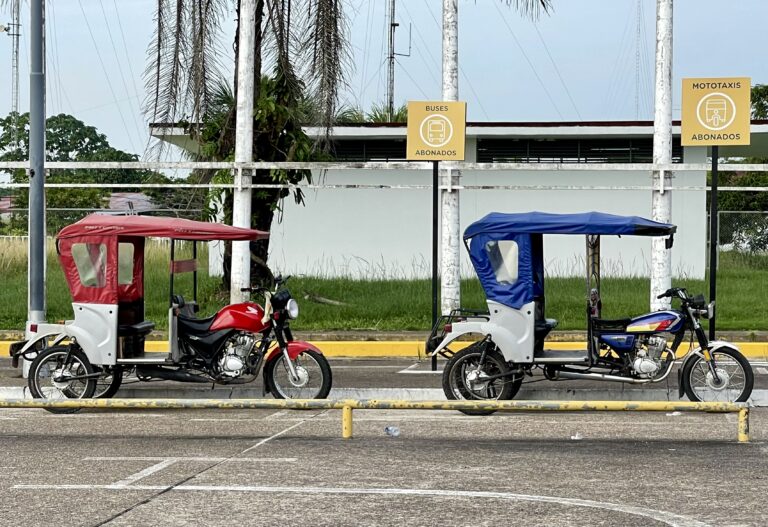
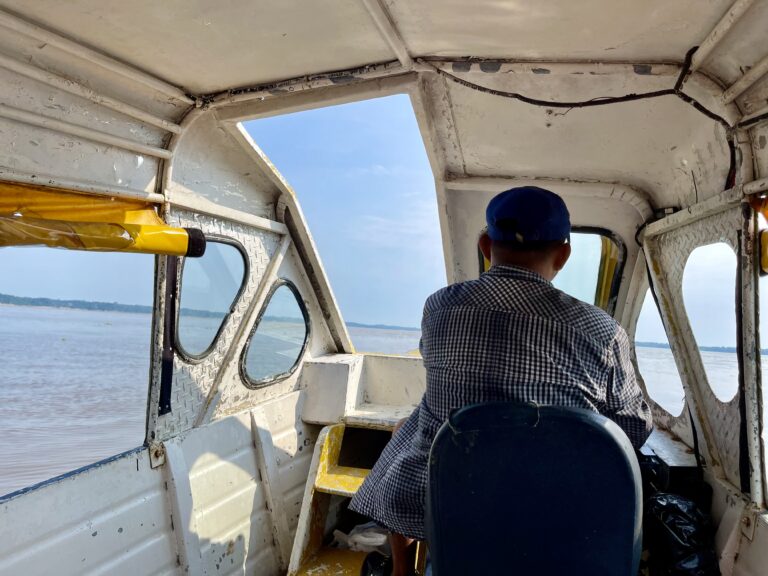
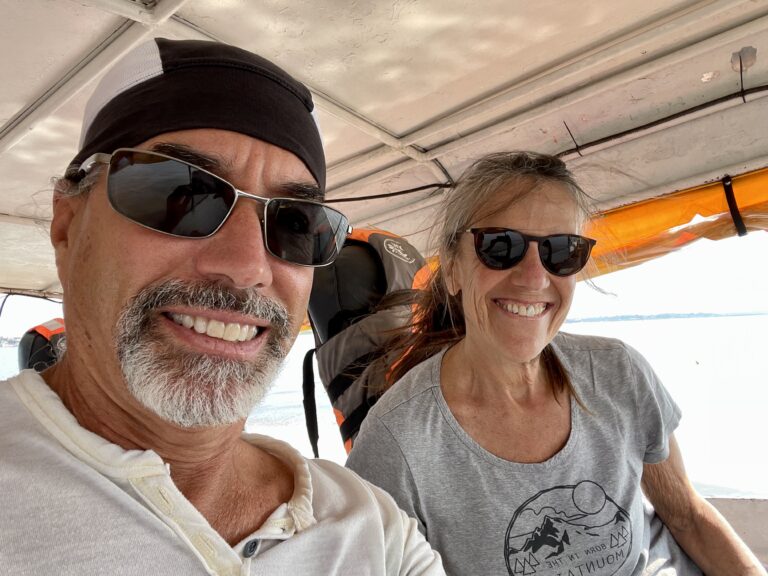
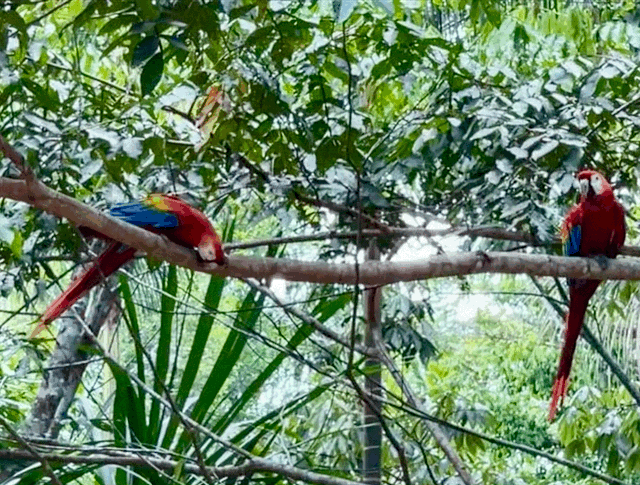
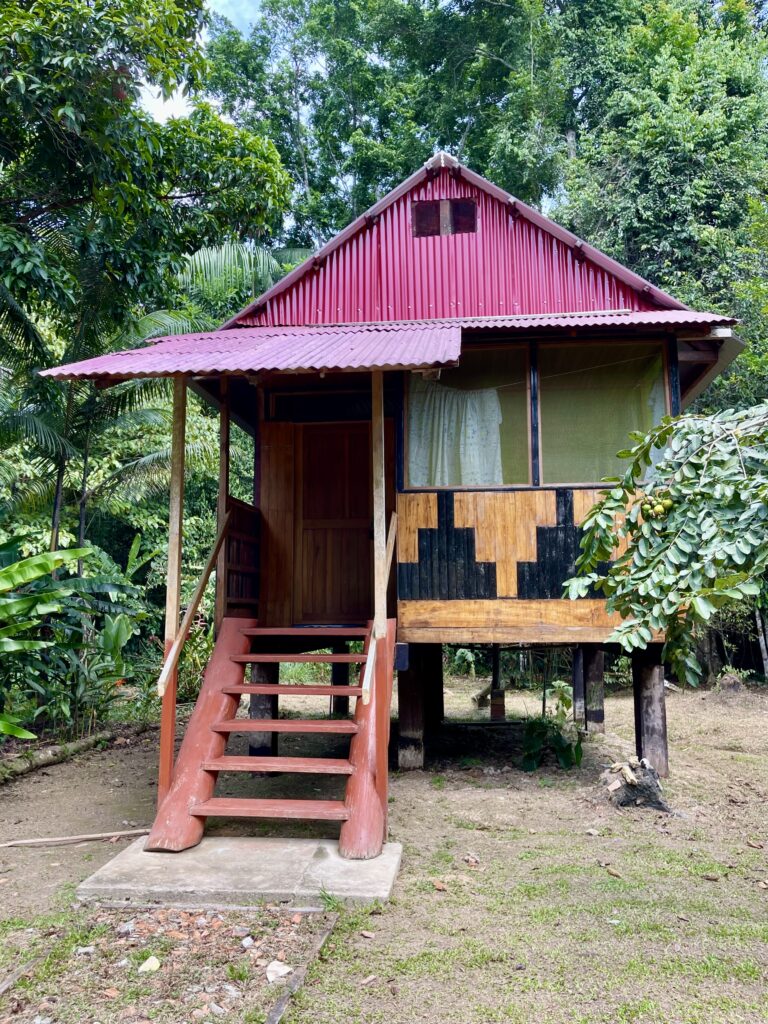
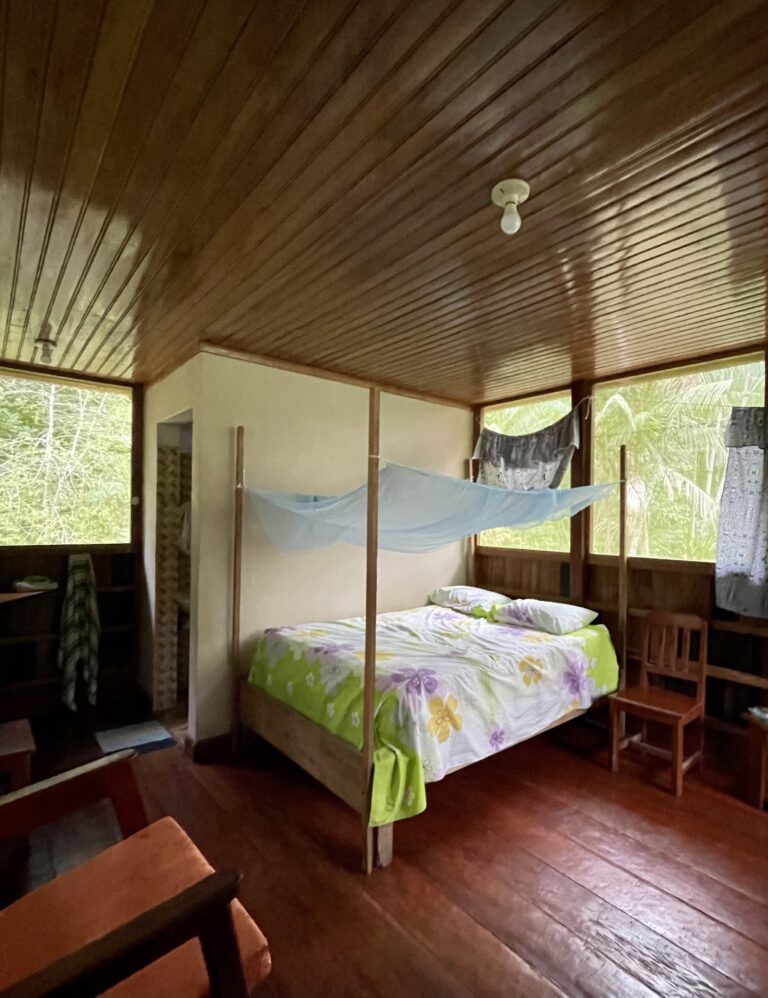
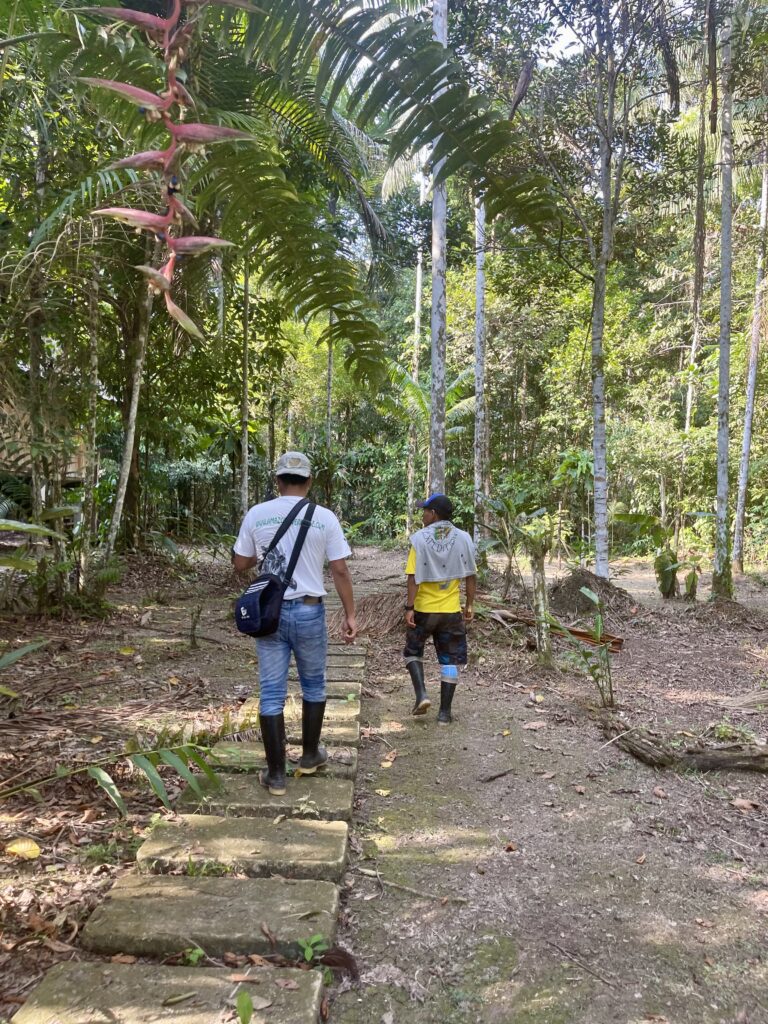
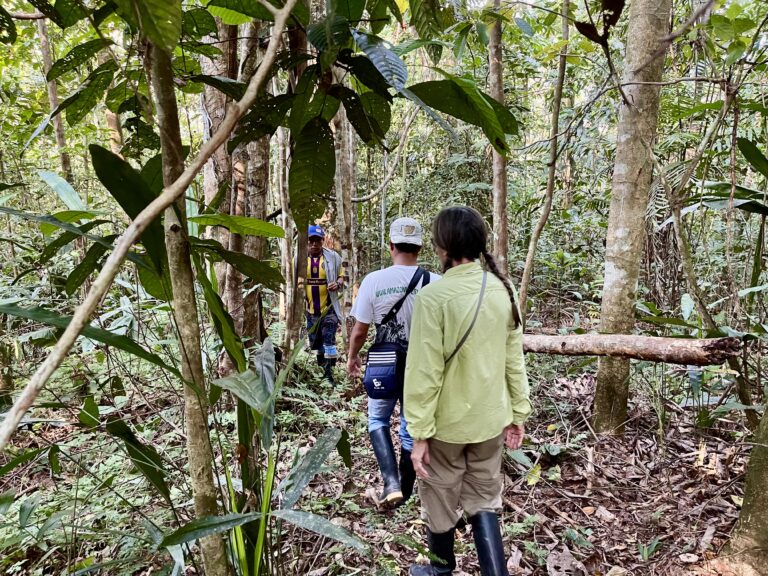
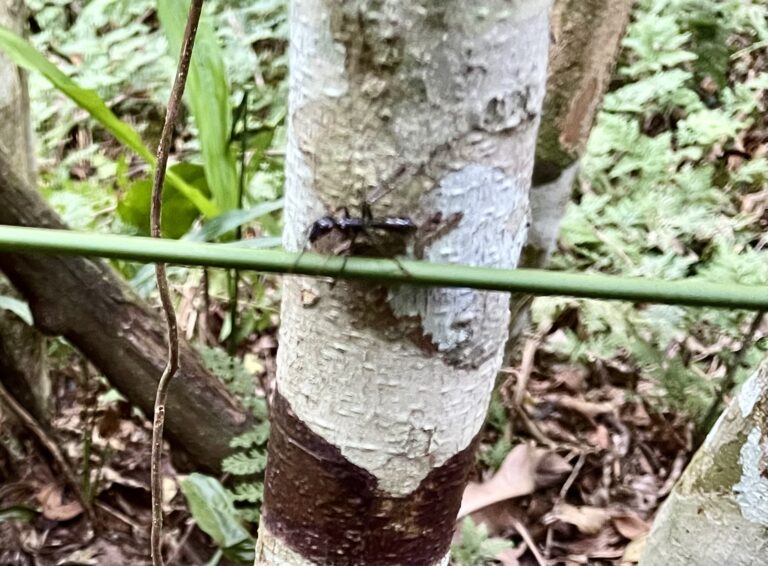
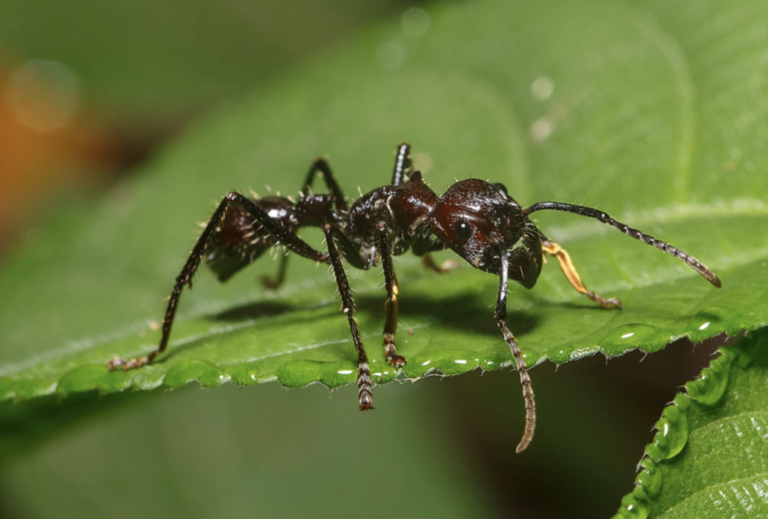
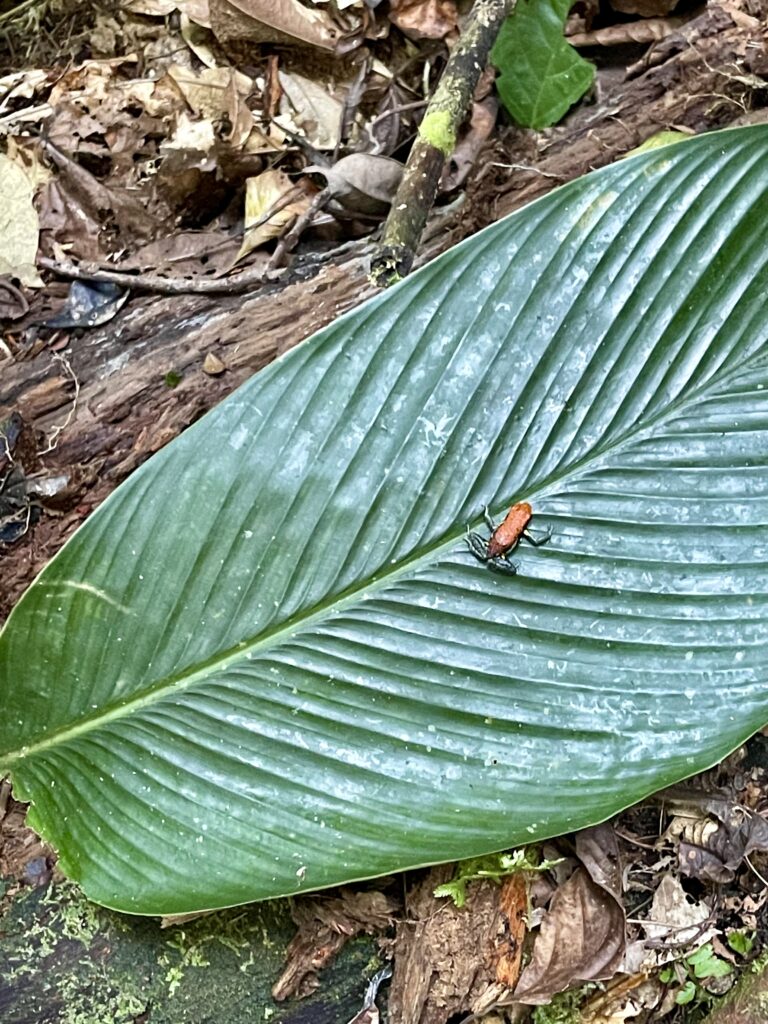
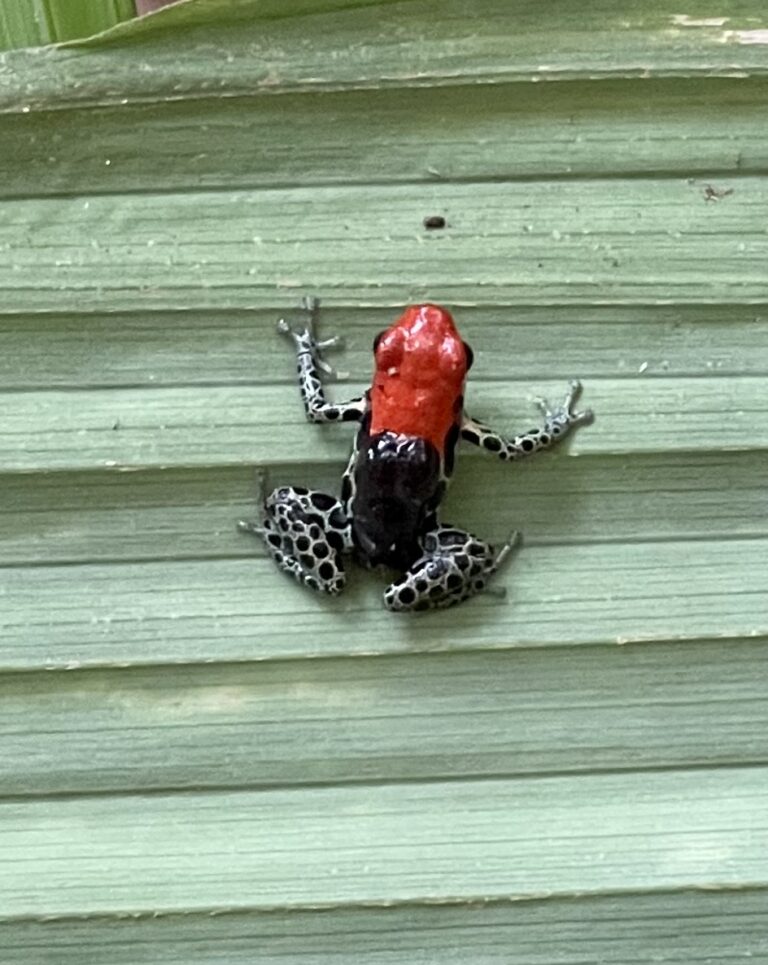
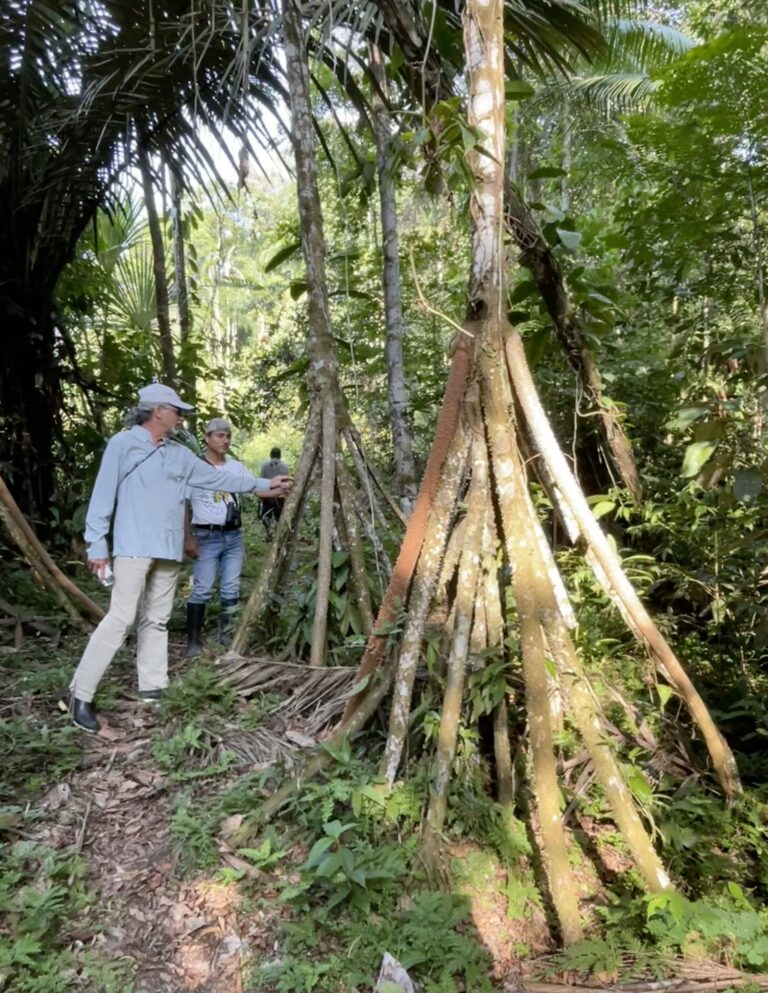
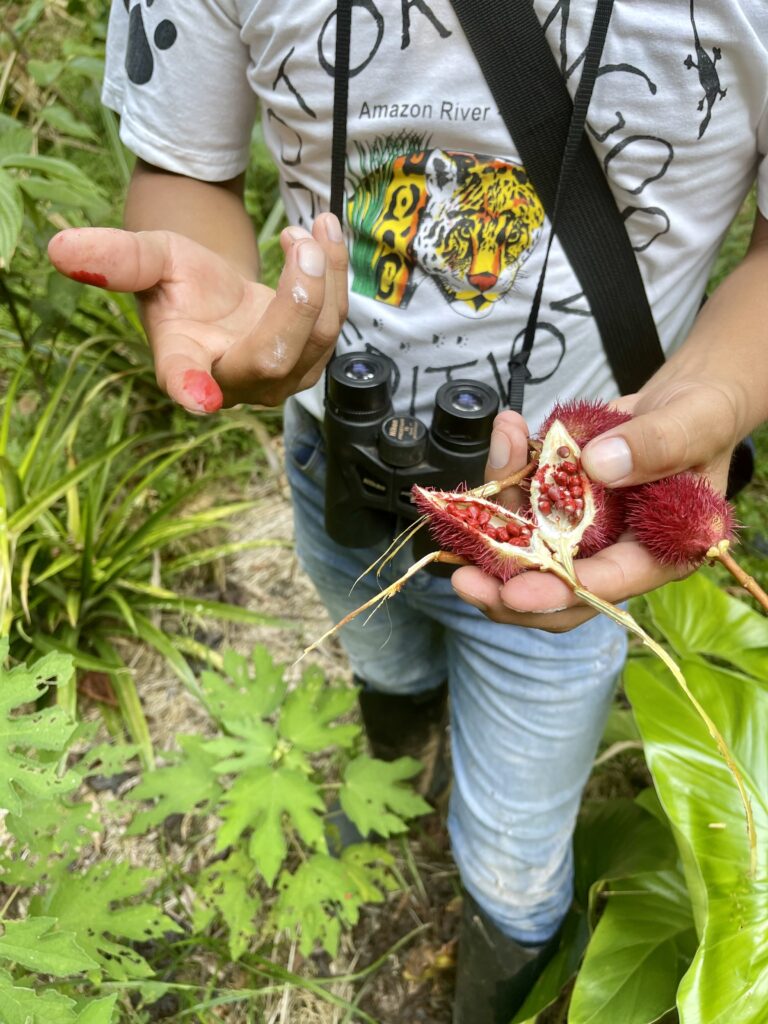
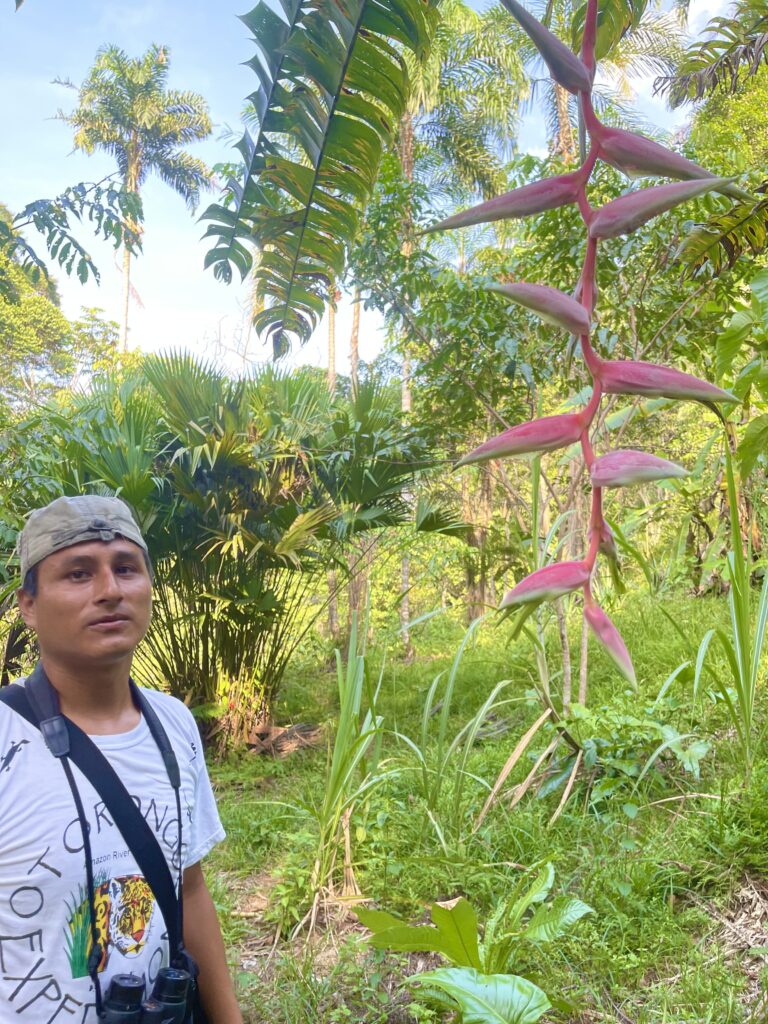
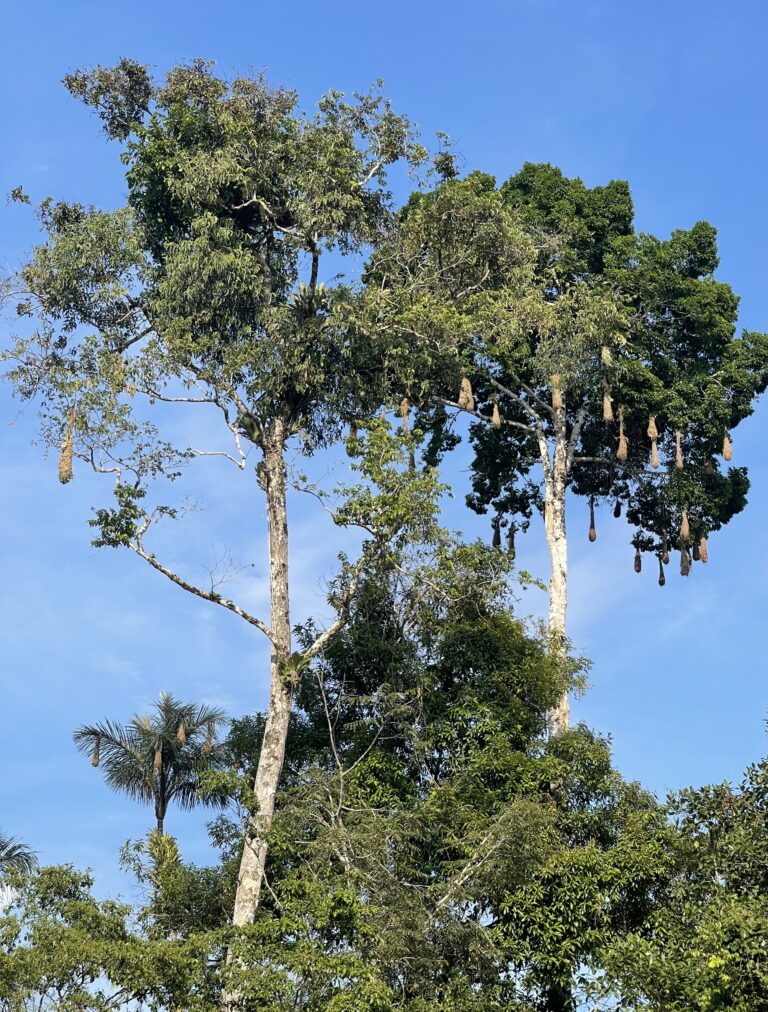
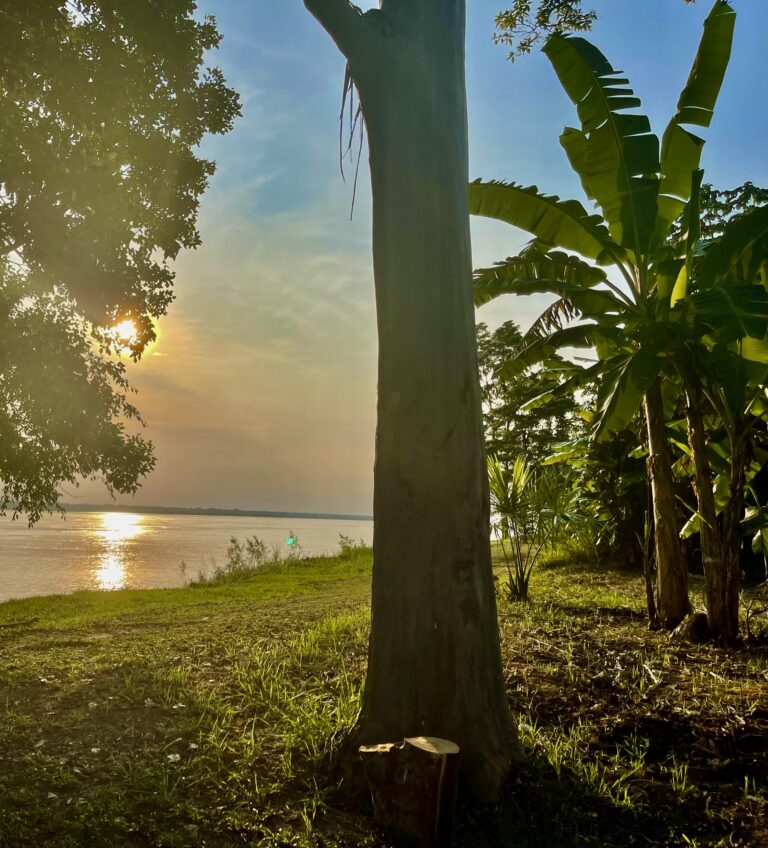
2 Responses
Stinging trees, biting ants, and poisonous frogs—but the views are gorgeous!